
Original Link: https://www.anandtech.com/show/7346/silverstone-precision-ps07-case-review-redux
SilverStone Precision PS07 Case Review Redux
by Dustin Sklavos on September 20, 2013 12:00 PM EST- Posted in
- Cases/Cooling/PSUs
- SilverStone
- MicroATX
_678x452.jpg)
During my tenure as case reviewer here, I've tried to avoid revisiting hardware whenever possible. There are a tremendous amount of cases available and more launching every day, so to go back and spend more time with something I've already tested is typically less fruitful for all involved. With that said, sometimes it's worth making an exception, and I absolutely believe the SilverStone Precision PS07 merits being checked out again.
The first time I reviewed the PS07 was more than a year and a half ago, when it launched. Yet what often happens with cases is that they see modest revisions during their lifespans. The manufacturers almost never publicize these revisions, but they're almost always positive. NZXT's initially much maligned H2 eventually had the door vent significantly widened to prevent it from suffering the same airflow issues our review unit did, and during the transition to USB 3.0, many manufacturers simply did a one-for-one swapped and replaced their USB 2.0 headers with USB 3.0. SilverStone is no different; the current PS07 is manufactured using thicker steel than the original, and SilverStone has replaced the middling fans they included in the original with quieter, more efficient models.
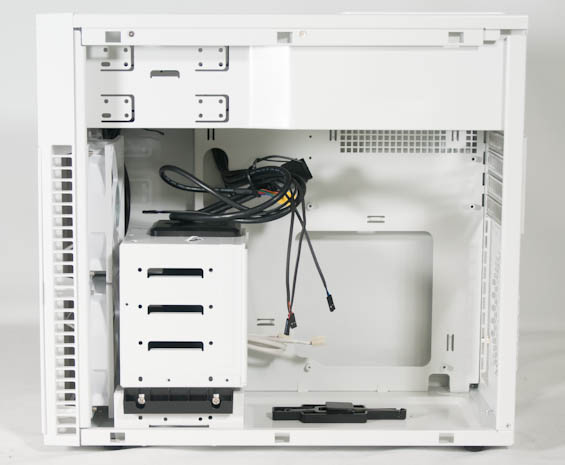
At the same time, there's been a bit of a dearth of strong Micro-ATX enclosures. Rosewill's Line-M is a good case, but not a great one; the Fractal Design Define Mini has acoustic padding but generally underperforms. The best Micro-ATX case I can really recommend at present is the Corsair Obsidian 350D, but that ignores SilverStone's entries from the year before. I was quite smitten with this enclosure design then, and our testing methodology has improved considerably since that time, so I'd like to see just how well it holds up.
One thing that hasn't changed is the assembly; rather than repeat myself, I'll simply direct you to the previous review so you can get a feel for it. This is essentially the design that the unfortunately overengineered Raven RV04 and Fortress FT04 are descended from, but the PS07 (and its fancier sibling, the Temjin TJ08-E) is a bit cleaner. It's still a SilverStone case, so assembly certainly isn't freshman level, but it's nowhere near the overcomplicated challenge the RV04 and FT04 are.
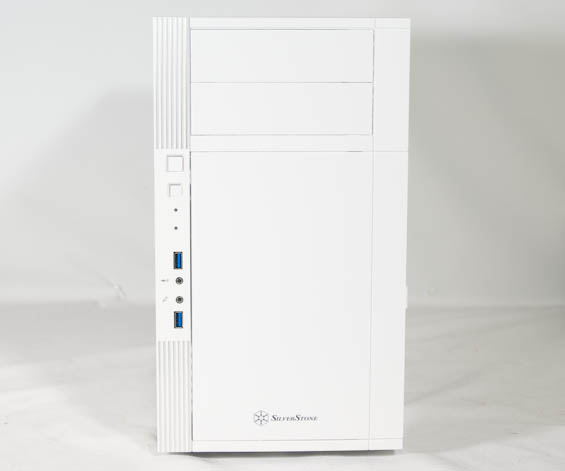
What I didn't see last time was the white model, and I found myself actually pretty smitten by it. The white paint job is going to be a little bit more prone to muss than the black one is, but it's at least distinctive, and overall it does a better job of blending together the plastic fascia with the steel body than the black one did. The two-toned stripes in the front are suited much better by the white in this reviewer's opinion.
| SilverStone Precision PS07 Specifications | ||
| Motherboard Form Factor | Mini-ITX, Micro-ATX | |
| Drive Bays | External | 2x 5.25" |
| Internal | 5x 3.5", 1x 2.5" | |
| Cooling | Front | 2x 120mm intake fan |
| Rear | 1x 120mm fan mount | |
| Top | - | |
| Side | - | |
| Bottom | - | |
| Expansion Slots | 4 | |
| I/O Port | 2x USB 3.0, 1x Headphone, 1x Mic | |
| Power Supply Size | ATX | |
| Clearances | HSF | 150mm |
| PSU | 160mm | |
| GPU | 330mm | |
| Dimensions |
15.75" x 8.27" x 14.73" 400mm x 210mm x 374mm |
|
| Special Features | Removable drive cage | |
| Price | $79 | |
The $80 price tag on the PS07 is competitive and puts it roughly in line with the other Micro-ATX cases. The $20 difference on the 350D and the Temjin TJ08-E is going to be worth considering, but I believe the comparative performance of the PS07 should also be a good indication of how well the overall superior TJ08-E will compete.
For testing Mini-ITX and Micro-ATX cases, we use the following standardized testbed in a stock configuration as well as with add-on graphics cards to get a feel for how well the case handles heat and noise. As we've retired our Micro-ATX board from the testbed, Micro-ATX enclosures will be using the Mini-ITX testbed.
| Mini-ITX Test Configuration | |
| CPU |
Intel Core i3-2120 (65W TDP) |
| Motherboard | Zotac Z68ITX-A-E |
| Graphics Card |
Intel HD 2000 IGP Zotac GeForce GTS 450 Eco ASUS GeForce GTX 560 Ti DCII TOP |
| Memory | 2x2GB Crucial Ballistix Smart Tracer DDR3-1600 |
| Drives | Kingston SSDNow V+ 100 64GB SSD |
| CPU Cooler | SilverStone NT07-1156 with Cooler Master ThermalFusion 400 |
| Power Supply | SilverStone Strider Plus 1000W 80 Plus Silver |
Each case is tested with just the Core i3's integrated graphics as well as with a discrete graphics card. The system is powered on and left idle for fifteen minutes, the thermal and acoustic results recorded, and then stressed by running four threads in Prime95 (in-place large FFTs) on the CPU, and OC Scanner (maximum load) is run when the dedicated GPU is installed. At the end of fiteen minutes, thermal and acoustic results are recorded. If the enclosure has a fan controller, these tests are repeated for each setting. Ambient temperature is also measured after the fifteen idle minutes but before the stress test and used to calculate the final reported results.
We try to maintain an ambient testing temperature of between 22C and 24C. Non-thermal test results aren't going to be directly comparable to the finest decimal point, but should be roughly comparable and give a broader idea of how the enclosure performs.
Thank You!
Before moving on, we'd like to thank the following vendors for providing us with the hardware used in our testbed.
- Thank you to Puget Systems for providing us with the Intel Core i3-2120.
- Thank you to Zotac for providing us with the Z68ITX-A-E motherboard and GeForce GTS 450 Eco.
- Thank you to Crucial for providing us with the Ballistix Smart Tracer memory.
- Thank you to Kingston for providing us with the SSDNow V+ 100 SSD.
- And thank you to SilverStone for providing us with the power supply and NT07-1156 heatsink/fan combo.
I'll admit I'm not especially happy with using the mini-ITX testbed for micro-ATX enclosures; the problem is that micro-ATX, despite being essentially the most logical form factor for the overwhelming majority of builds, still has tremendous difficulty gaining traction in the industry. I've heard from higher ups at a lot of different manufacturers that micro-ATX doesn't really sell as well as it ought to; enthusiasts and more mainstream builders are still leaning towards full ATX, while mini-ITX is gaining obvious traction for simpler designs.
With all that in mind, I've actually used the SilverStone PS07's senior sibling, the Temjin TJ08-E, for a more powerful build and found it to be exceptional. This thermal design has a lot to recommend it, but it's interesting to see if SilverStone's eye towards efficiency helps distinguish the PS07 from the competing cases.
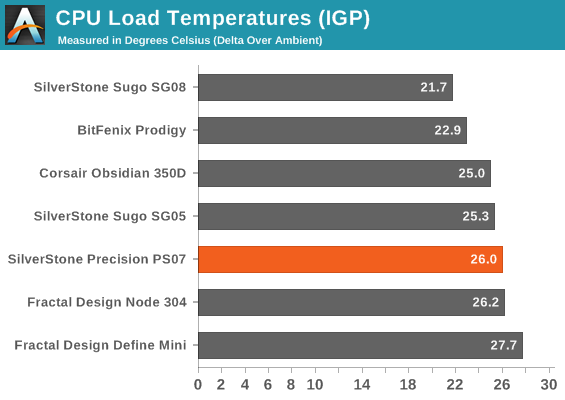
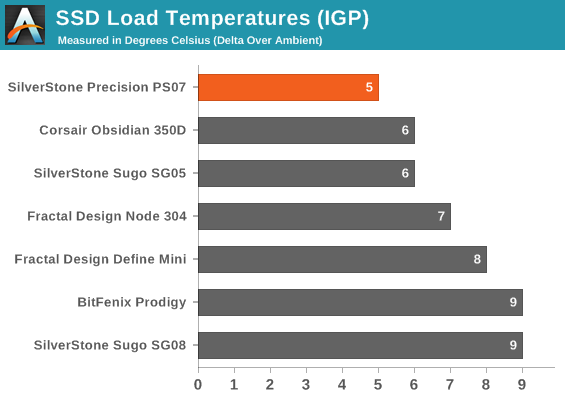
Thermals are good but not great. Keep in mind that the mini-ITX testbed uses a traditional downward-directed air cooler as opposed to a tower cooler; anecdotally, my experience is that tower coolers perform tremendously well in this chassis.
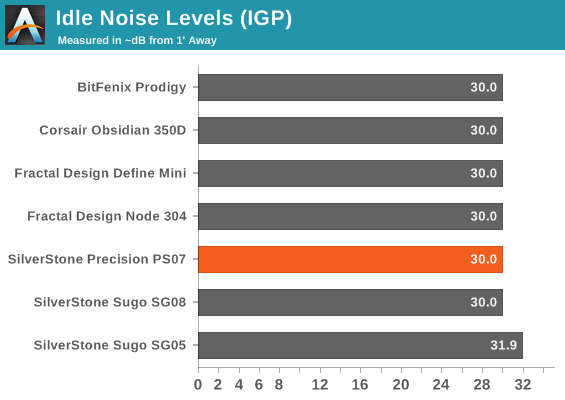
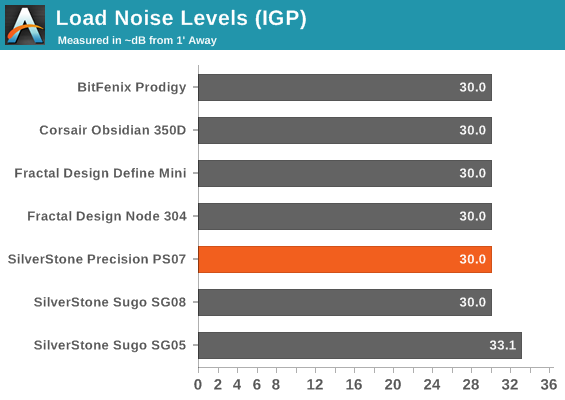
It's as quiet as any of the others, though. This is batting pretty far below the PS07's class.
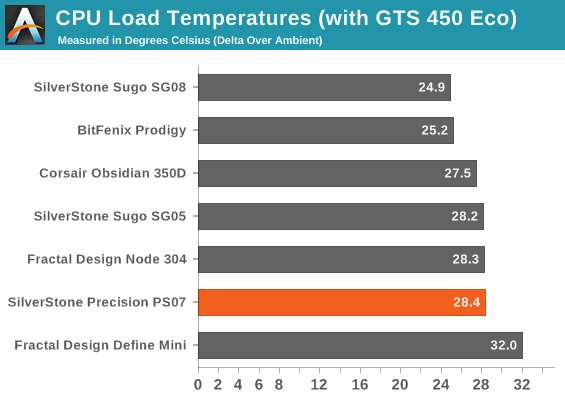
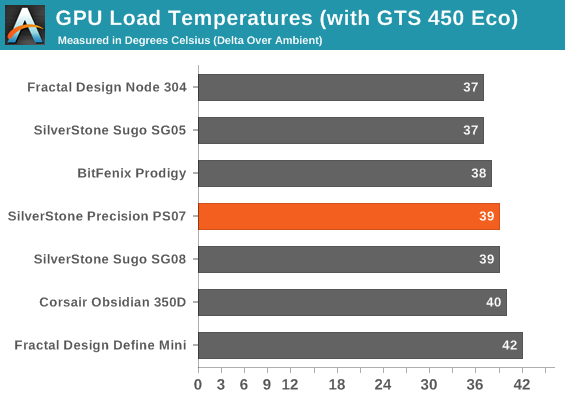
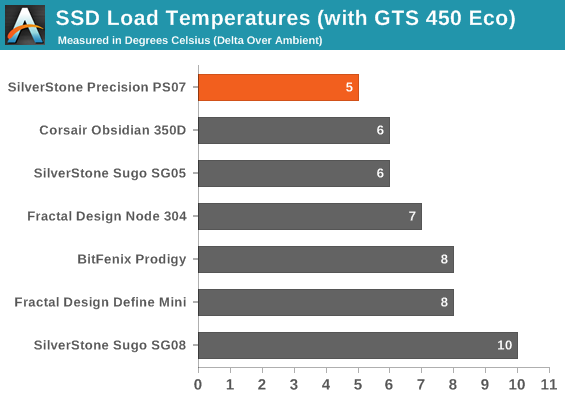
Install a more modest HTPC style configuration and the PS07's performance is still a bit iffy. It competes but not especially strongly.
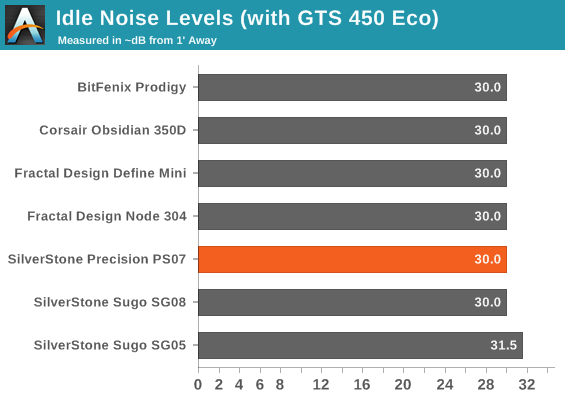
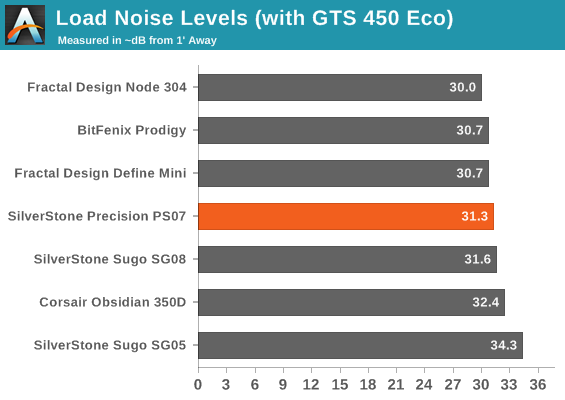
While the original version of the PS07 isn't listed here, I can confirm independently that the newer fans in this revision are most definitely quieter. Noise levels aren't ideal, but they're at least on the low side. Note that the PS07 runs substantially cooler than the Fractal Design Define Mini while being only fractionally louder.
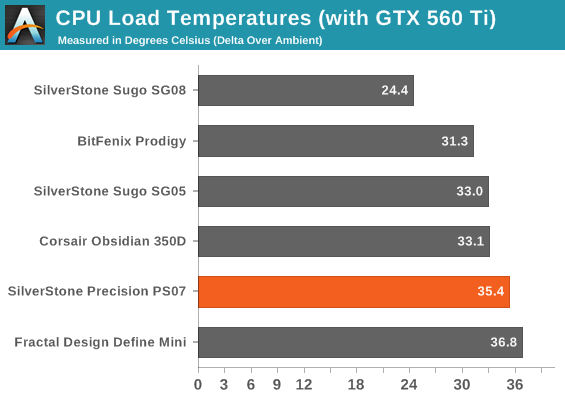
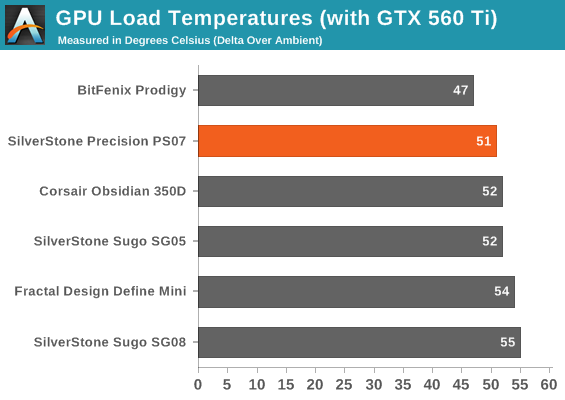
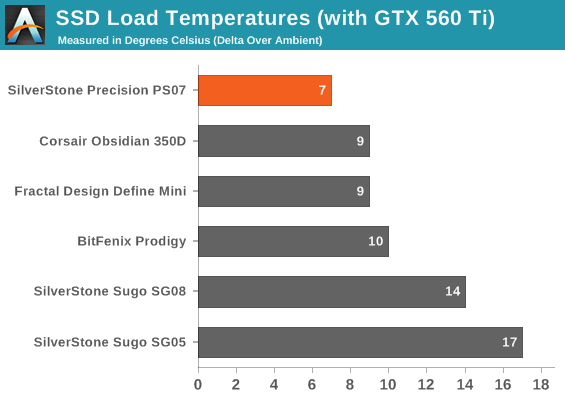
Switch over to a more powerful graphics card and the PS07 starts really punching its weight. It's running consistently cooler than Fractal Design's Define Mini, while the Corsair Obsidian 350D offers better thermal performance but in a larger footprint.
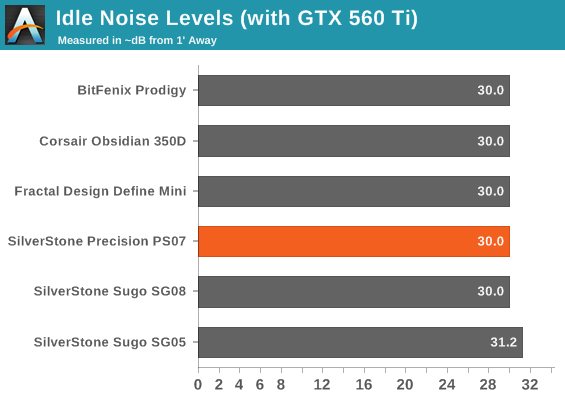
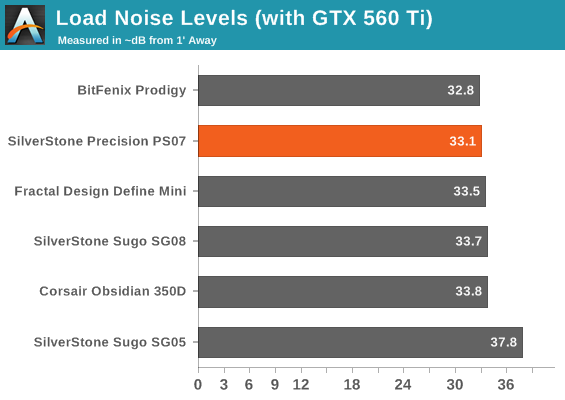
And there's the proof. The PS07 is ever so slightly quieter than almost all of the competing cases.
The essential takeaway from the performance results here is that the PS07 becomes increasingly competitive the more you tax it. Fractal Design's Define Mini requires too much handholding to really shine, while the Corsair Obsidian 350D is by all rights not really an air cooling case and not designed with that in mind.
Revisiting the SilverStone Precision PS07 was definitely a worthwhile endeavor, even if the performance results don't immediately bear that out. There's some extrapolation that has to be done, and some dots that need connecting, but SilverStone's assertions that this case was still competitive and was in fact well acoustically engineered were both correct.
Where things get interesting is the way the micro-ATX market stratifies. Despite the fact that they're all hanging out in the same price neighborhood, the PS07, the Corsair Obsidian 350D, and the Fractal Design Define Mini all serve very different purposes. Of these three primary competitors, I think the Define Mini has the hardest time justifying itself, owing to Fractal Design's continuing struggles to achieve competitive thermal performance.
The PS07 and 350D may superficially look like they're competing with one another, but the 350D is a larger enclosure and is very clearly engineered more for water cooling. The PS07, in contrast, leverages a strong but specific air cooling design. This is the essential dichotomy that we're running into: SilverStone's airflow designs are typically excellent but you basically sacrifice any kind of liquid cooling outside of a 120mm CLC on the CPU. SilverStone will pay lip service to the idea of putting a custom liquid system in their cases, but it's obvious that it's an afterthought.

I'm tremendously bullish on the PS07 as an excellent mid-tower option for the majority of users. One micro-ATX board, one video card, stick an SSD and a hard drive in there and put a cheap tower cooler on the CPU: presto, an incredibly well rounded system.
So now that we have a more modern appraisal of both the PS07 and its eventually lineage in the Raven RV04 and Fortress FT04, an unfortunately unpleasant pattern does essentially emerge when we do a "State of the Union" in the case industry. In my estimation, there are three manufacturers that are driving things forward the way Antec used to in the days of old: Corsair, SilverStone, and NZXT. BitFenix is running fourth, but they don't really directly compete with these three because they've pretty much locked up the budget market.
SilverStone is continually demonstrating an expert understanding of designing air flow in their enclosures, but their designs still suffer from two fatal flaws: overcomplication, and a lack of forward thinking. They have the airflow thing down pat and continue to innovate there, but these cases are often needlessly complicated to work with. At the same time, they ignore the industry trends toward CLCs and away from 3.5" storage at their own peril.
Moving back from the macro to the micro, for more modest builds the Precision PS07 and its fancier sibling, the Temjin TJ08-E, continues to be one of the best options out there. The $79 price tag is totally reasonable, and if you choose your components intelligently (and inexpensively!) you can be left with a very quiet, solidly performing system.

_thumb.jpg)
_thumb.jpg)
_thumb.jpg)
_thumb.jpg)
_thumb.jpg)
_thumb.jpg)
_thumb.jpg)
_thumb.jpg)
_thumb.jpg)
_thumb.jpg)
_thumb.jpg)
_thumb.jpg)






